
Last February 16, 2018, the National Artist for Sculpture, Napoleón Isabelo “Billy” Veloso Abueva (1930-2018), passed away after battling the effects of a stroke for 10 years. And on the 24th of February, we all gave our fond farewells to the master at the Tanghalan Nicanor Abelardo, the main theater of the Cultural Center of the Philippines (CCP). After the tribute ceremonies, Abueva’s remains was then transferred by members of the Armed Forces of the Philippines (AFP) to its final resting place at the Libingan ng mga Bayani (Cemetery of the Heroes).

The whole ceremony was fitting of the man whose life was dedicated to creating art, and uplifting the state of art in the Philippines. At the commencement of the rite, Abueva’s coffin was placed on the stage, hidden by the grand tapestry of his contemporary, Hernando Ruiz Ocampo (1911-1978), entitled “Genesis”. Likening to the hand of God, amidst the fires of creation, Abueva’s works broke the barriers of the art scene in the 1950s, ushering a new modernism into the disciplines of sculpture, that had been previously been dominated by classicism and Art Deco styles. After establishing himself at a very young age, Abueva was now mentoring the next generation of sculptors. This gave rise to his title as the Father of Modern Philippine Sculpture.
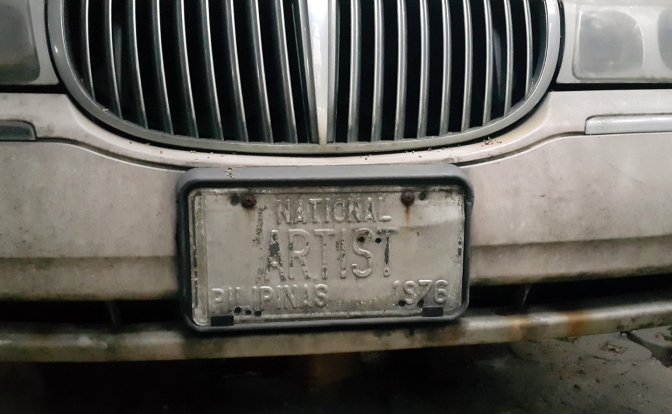
There is much to be told of Napoleon Abueva, for his early days as a creative child in the island of Bohol, to his years at the University of the Philippines (UP) College of Fine Arts (CFA) as a student under Guillermo Tolentino (1890-1976), a teacher, and later on the dean. There are also his numerous honors, with the highest distinction as the Pambansang Alagad ng Sining ng Pilipinas (National Artist of the Philippines), which he was awarded in 1976, making him the youngest recipient to this day. And there also the many lives he has touched, with the numerous artistic careers he nurtured through the years, as well as the thousands of sculptures that he has created, with many standing as monuments in various public spaces throughout the country and abroad.
However, what is seldom spoken about is the deep religious faith that Abueva had, and how he tried to give to every church or religious organization that would approach him for help. His wife once said that while in the middle of several major sculptural commissions, Abueva would drop these projects if any Catholic organization or parish would ask him for a new sculpture for their church. One perfect example of his generosity towards churches are the many pieces scattered throughout the San Lorenzo Ruiz Parish, which is just a few steps from his home-studio, in Quezon City.
Mang Billy explored many themes of the Christian belief, and among the earliest pieces were 1955 the Altar with the Sermon at the Mount (Gospel of Matthew: chapters 5, 6, and 7) and Lectern with the Twelve Apostles, at the Parish of the Holy Sacrifice, in the University of the Philippines, Diliman campus.
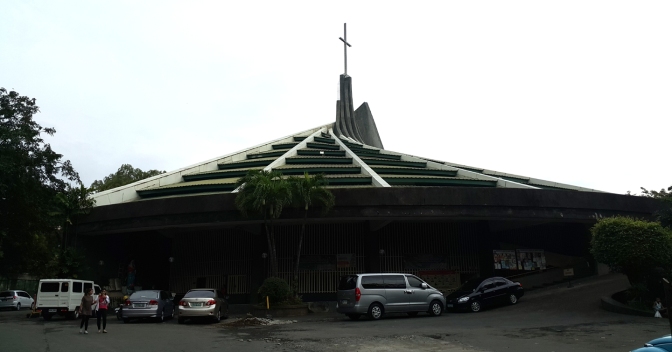
One of his favorite challenges was reinterpreting the fourteen (14) Stations of the Cross, or Via Crusis. The Via Crusis were 14 depictions of events of the Passion of Jesus Christ, sometimes starting with the Last Supper or the Condemnation by Pontius Pilate, and ending with either the Death or Resurrection of Jesus Christ. One of his earliest examples of the Via Crusis, are the 14 carved molave wood (Vitex Parviflora) pieces, at the Immaculate Heart of Mary Parish, in Quezon City.
Abueva’s first public works in religious art started when the maverick Jesuit priest, Fr. John Patrick Delaney SJ (1906-1956), took a chance on a young architect Leandro Valencia Locsin (1928-1994) and the veteran modernist painter Vicente Silva Manansala (1910-1981), to design the Parish of the Holy Sacrifice, for the University of the Philippines. Manansala brought with him three upcoming artists, Ang Kiukok (1931-2005), Arturo Rogerio Luz (born 1926), and Napoleon Abueva. All five men would later be honored as National Artists, and this project would become the start of many collaborations between Abueva and Locsin; such as the Saint Andrew the Apostle Parish in Makati City (1968), the Immaculate Heart of Mary Parish in Quezon City (1975), and the Saint Alphonsus Maria de Liguori Parish in Makati City (1968).
The Abueva-Locsin partnership was not limited to the architecture, as Abueva brought his own outtake of the Philippine Christmas, with his 1982 retablo (altarpiece) Dambana ng Pasko (Altar of Christmas) at the lobby of the Philippine International Convention Center (1976), which was designed by Locsin.
Soon other architects wanted to collaborate with Abueva in the churches they were designing, starting with National Artist Arch. Francisco “Bobby” Tronqued Mañosa (1931-2019) consulting with Leandro Locsin & William V. Coscolluela, for the Shrine of Mary, Queen of Peace (Our Lady of EDSA), at the boundary of Quezon City and San Juan City. Mañosa called upon many artists to contribute their efforts to commemorate the Catholic Church mobilized People Power Revolution of 1986 with artworks for the chapel. Among them were Virginia Ty-Navarro, Ben Alano, Dominic Galicia, Ramon Orlina, Manny Casal, and Napoleon Abueva. Mang Billy designed the main altar of the chapel, and the Fourteen Stations of the Cross at exterior garden.
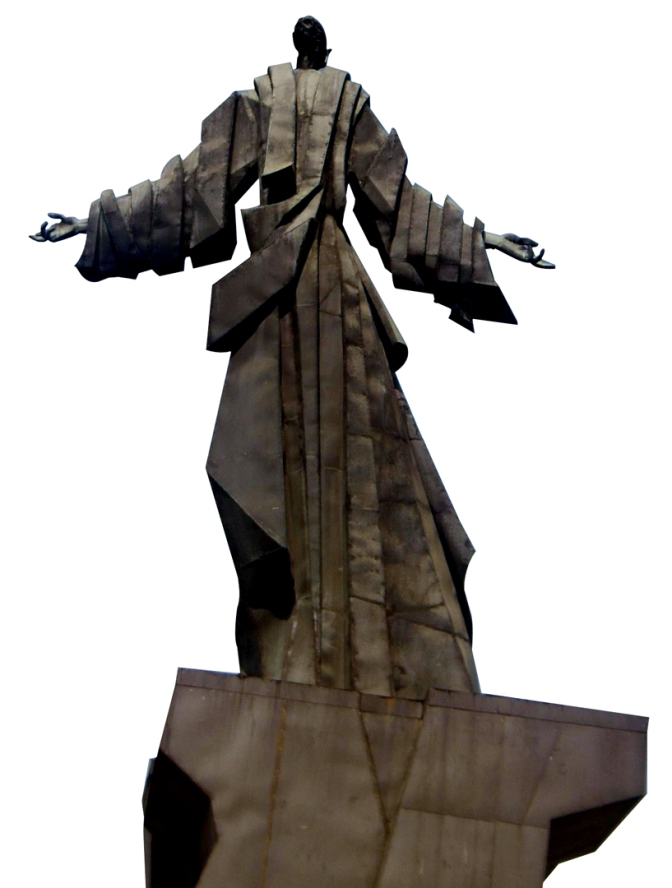
Despite the many sculptures that Abueva has done for all these churches, one of his favorite themes is that of the Triumphant Christ. This is best exemplified by his 10 meter tall Christ Transfigured (1979), at the Eternal Gardens Memorial Park, in Caloocan City.
Abueva’s first known work of the Triumphant Christ was when he broke tradition for portraying the Jesus crucified at the altar of churches, when he worked for the Parish of the Holy Sacrifice. Here, Abueva created a two-sided crucifix, with The Crucified Christ or one side and The Risen Christ at the other.
Some other examples of Abueva’s Triumphant Christ is the 2003 Victorious Crucifix, found in the Our Lady of the Pentecost Parish, in Loyola Heights, Quezon City, and The Risen Christ at the Sacred Heart Novitiate, in Novaliches, Quezon City.
And at the San Lorenzo Ruiz Parish, Abueva expresses “The Resurrected Christ” in the church’s altar crucifix as a dignified Jesus stands in front of the cross with even his arms still nailed, and a sculpture set at the back of the parish of Jesus rising from his tomb facing the dawn.
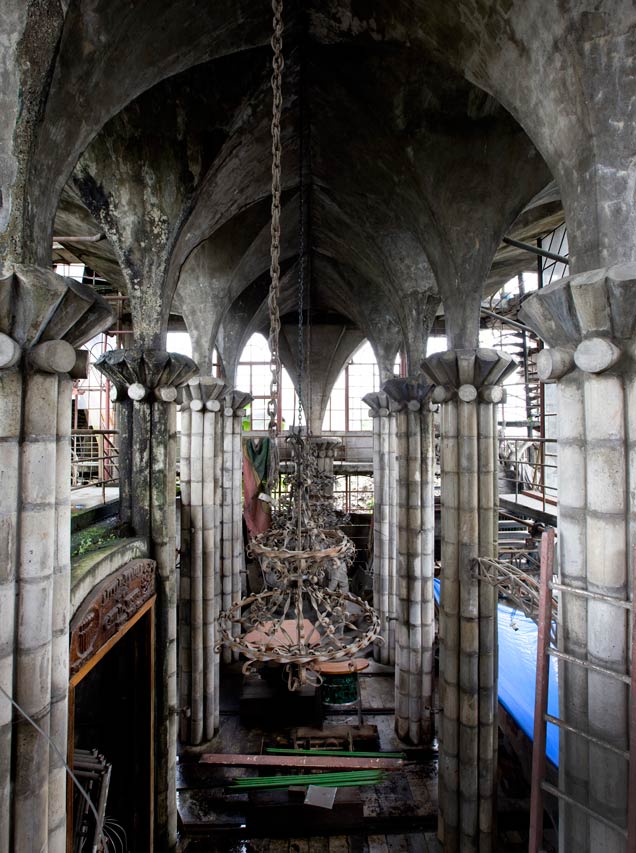
However, Abueva’s greatest expressions of faith are his experiments into architectural sculpture. His most noted piece is the Gothic styled temple, which he started working on as an on-going project since the mid-1990s. Located in his home-studio compound, the temple has many sculpture protruding throughout its multi-leveled and winding floors, such as the Finding of the young Jesus at the Temple (Luke 2:41-52) at the ground floor, and Lucifer Tempting Christ in the Desert (Matthew 4:1–11) at the roof deck. This was Abueva’s answer to Antonio Gaudi’s Sagrada Familia Cathedral, which both men never saw their masterpieces completed.
But the architectural sculpture where Abueva truly shows his devotion to the Resurrection of Christ has no image of Jesus at all. This is the Interfaith Chapel at the Southwestern University, in Cebu City. Built in the 1990s, the chapel was designed to symbolize the tomb of Christ, and when the sacristans pull on the weights at the ends of some pulleys, the door will roll over to reveal an empty tomb, and the roof would open up to the heavens.
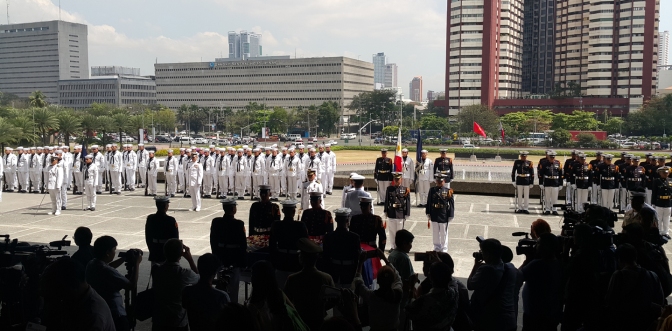
Now that his journey in the this reality is over, and his earthly remains are interred with other heroes of the Philippines, we cannot he but wonder what is Napoleon Abueva creating in the afterlife, now that he is freed of his earthly sufferings. We all remember the man, not just a great artist who has influenced generations of sculptors and changed the face of society, but we also remember the friend, husband, father and grandfather, who never lost his cool. We remember the man who gave all to his friends and community, and never asked anything back.
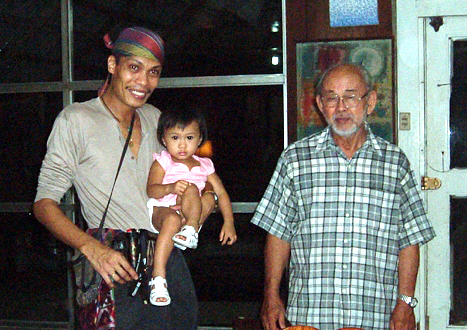
Thank you, Sir Billy.
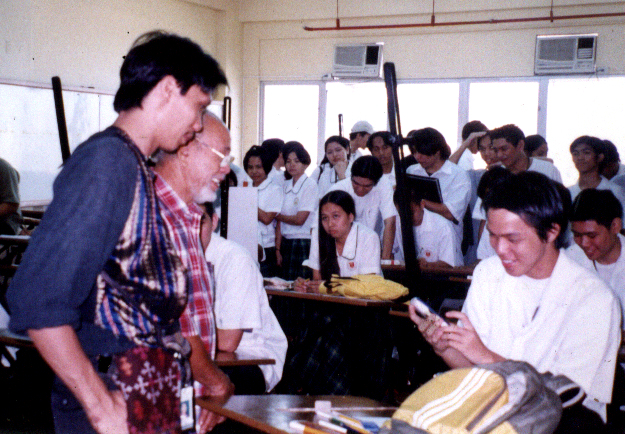
























































31 thoughts on “In Memoriam: The Resurrection of Abueva”